Heli Qi
DisasterM3: A Remote Sensing Vision-Language Dataset for Disaster Damage Assessment and Response
May 27, 2025Abstract:Large vision-language models (VLMs) have made great achievements in Earth vision. However, complex disaster scenes with diverse disaster types, geographic regions, and satellite sensors have posed new challenges for VLM applications. To fill this gap, we curate a remote sensing vision-language dataset (DisasterM3) for global-scale disaster assessment and response. DisasterM3 includes 26,988 bi-temporal satellite images and 123k instruction pairs across 5 continents, with three characteristics: 1) Multi-hazard: DisasterM3 involves 36 historical disaster events with significant impacts, which are categorized into 10 common natural and man-made disasters. 2)Multi-sensor: Extreme weather during disasters often hinders optical sensor imaging, making it necessary to combine Synthetic Aperture Radar (SAR) imagery for post-disaster scenes. 3) Multi-task: Based on real-world scenarios, DisasterM3 includes 9 disaster-related visual perception and reasoning tasks, harnessing the full potential of VLM's reasoning ability with progressing from disaster-bearing body recognition to structural damage assessment and object relational reasoning, culminating in the generation of long-form disaster reports. We extensively evaluated 14 generic and remote sensing VLMs on our benchmark, revealing that state-of-the-art models struggle with the disaster tasks, largely due to the lack of a disaster-specific corpus, cross-sensor gap, and damage object counting insensitivity. Focusing on these issues, we fine-tune four VLMs using our dataset and achieve stable improvements across all tasks, with robust cross-sensor and cross-disaster generalization capabilities.
DynamicVL: Benchmarking Multimodal Large Language Models for Dynamic City Understanding
May 27, 2025Abstract:Multimodal large language models have demonstrated remarkable capabilities in visual understanding, but their application to long-term Earth observation analysis remains limited, primarily focusing on single-temporal or bi-temporal imagery. To address this gap, we introduce DVL-Suite, a comprehensive framework for analyzing long-term urban dynamics through remote sensing imagery. Our suite comprises 15,063 high-resolution (1.0m) multi-temporal images spanning 42 megacities in the U.S. from 2005 to 2023, organized into two components: DVL-Bench and DVL-Instruct. The DVL-Bench includes seven urban understanding tasks, from fundamental change detection (pixel-level) to quantitative analyses (regional-level) and comprehensive urban narratives (scene-level), capturing diverse urban dynamics including expansion/transformation patterns, disaster assessment, and environmental challenges. We evaluate 17 state-of-the-art multimodal large language models and reveal their limitations in long-term temporal understanding and quantitative analysis. These challenges motivate the creation of DVL-Instruct, a specialized instruction-tuning dataset designed to enhance models' capabilities in multi-temporal Earth observation. Building upon this dataset, we develop DVLChat, a baseline model capable of both image-level question-answering and pixel-level segmentation, facilitating a comprehensive understanding of city dynamics through language interactions.
Seeing is Believing, but How Much? A Comprehensive Analysis of Verbalized Calibration in Vision-Language Models
May 26, 2025Abstract:Uncertainty quantification is essential for assessing the reliability and trustworthiness of modern AI systems. Among existing approaches, verbalized uncertainty, where models express their confidence through natural language, has emerged as a lightweight and interpretable solution in large language models (LLMs). However, its effectiveness in vision-language models (VLMs) remains insufficiently studied. In this work, we conduct a comprehensive evaluation of verbalized confidence in VLMs, spanning three model categories, four task domains, and three evaluation scenarios. Our results show that current VLMs often display notable miscalibration across diverse tasks and settings. Notably, visual reasoning models (i.e., thinking with images) consistently exhibit better calibration, suggesting that modality-specific reasoning is critical for reliable uncertainty estimation. To further address calibration challenges, we introduce Visual Confidence-Aware Prompting, a two-stage prompting strategy that improves confidence alignment in multimodal settings. Overall, our study highlights the inherent miscalibration in VLMs across modalities. More broadly, our findings underscore the fundamental importance of modality alignment and model faithfulness in advancing reliable multimodal systems.
MMLU-ProX: A Multilingual Benchmark for Advanced Large Language Model Evaluation
Mar 13, 2025

Abstract:Traditional benchmarks struggle to evaluate increasingly sophisticated language models in multilingual and culturally diverse contexts. To address this gap, we introduce MMLU-ProX, a comprehensive multilingual benchmark covering 13 typologically diverse languages with approximately 11,829 questions per language. Building on the challenging reasoning-focused design of MMLU-Pro, our framework employs a semi-automatic translation process: translations generated by state-of-the-art large language models (LLMs) are rigorously evaluated by expert annotators to ensure conceptual accuracy, terminological consistency, and cultural relevance. We comprehensively evaluate 25 state-of-the-art LLMs using 5-shot chain-of-thought (CoT) and zero-shot prompting strategies, analyzing their performance across linguistic and cultural boundaries. Our experiments reveal consistent performance degradation from high-resource languages to lower-resource ones, with the best models achieving over 70% accuracy on English but dropping to around 40% for languages like Swahili, highlighting persistent gaps in multilingual capabilities despite recent advances. MMLU-ProX is an ongoing project; we are expanding our benchmark by incorporating additional languages and evaluating more language models to provide a more comprehensive assessment of multilingual capabilities.
Segment Anything with Multiple Modalities
Aug 17, 2024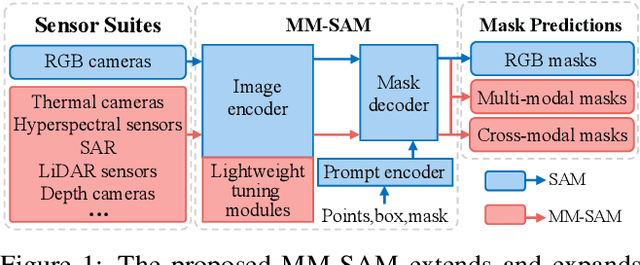



Abstract:Robust and accurate segmentation of scenes has become one core functionality in various visual recognition and navigation tasks. This has inspired the recent development of Segment Anything Model (SAM), a foundation model for general mask segmentation. However, SAM is largely tailored for single-modal RGB images, limiting its applicability to multi-modal data captured with widely-adopted sensor suites, such as LiDAR plus RGB, depth plus RGB, thermal plus RGB, etc. We develop MM-SAM, an extension and expansion of SAM that supports cross-modal and multi-modal processing for robust and enhanced segmentation with different sensor suites. MM-SAM features two key designs, namely, unsupervised cross-modal transfer and weakly-supervised multi-modal fusion, enabling label-efficient and parameter-efficient adaptation toward various sensor modalities. It addresses three main challenges: 1) adaptation toward diverse non-RGB sensors for single-modal processing, 2) synergistic processing of multi-modal data via sensor fusion, and 3) mask-free training for different downstream tasks. Extensive experiments show that MM-SAM consistently outperforms SAM by large margins, demonstrating its effectiveness and robustness across various sensors and data modalities.
CAT-SAM: Conditional Tuning Network for Few-Shot Adaptation of Segmentation Anything Model
Feb 06, 2024


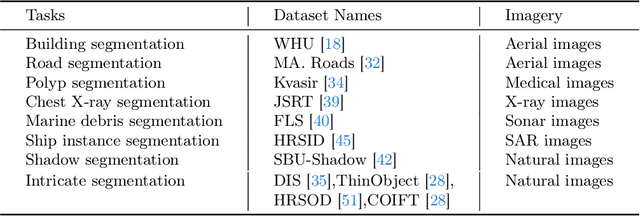
Abstract:The recent Segment Anything Model (SAM) has demonstrated remarkable zero-shot capability and flexible geometric prompting in general image segmentation. However, SAM often struggles when handling various unconventional images, such as aerial, medical, and non-RGB images. This paper presents CAT-SAM, a ConditionAl Tuning network that adapts SAM toward various unconventional target tasks with just few-shot target samples. CAT-SAM freezes the entire SAM and adapts its mask decoder and image encoder simultaneously with a small number of learnable parameters. The core design is a prompt bridge structure that enables decoder-conditioned joint tuning of the heavyweight image encoder and the lightweight mask decoder. The bridging maps the prompt token of the mask decoder to the image encoder, fostering synergic adaptation of the encoder and the decoder with mutual benefits. We develop two representative tuning strategies for the image encoder which leads to two CAT-SAM variants: one injecting learnable prompt tokens in the input space and the other inserting lightweight adapter networks. Extensive experiments over 11 unconventional tasks show that both CAT-SAM variants achieve superior target segmentation performance consistently even under the very challenging one-shot adaptation setup. Project page: \url{https://xiaoaoran.github.io/projects/CAT-SAM}
SpeeChain: A Speech Toolkit for Large-Scale Machine Speech Chain
Jan 08, 2023Abstract:This paper introduces SpeeChain, an open-source Pytorch-based toolkit designed to develop the machine speech chain for large-scale use. This first release focuses on the TTS-to-ASR chain, a core component of the machine speech chain, that refers to the TTS data augmentation by unspoken text for ASR. To build an efficient pipeline for the large-scale TTS-to-ASR chain, we implement easy-to-use multi-GPU batch-level model inference, multi-dataloader batch generation, and on-the-fly data selection techniques. In this paper, we first explain the overall procedure of the TTS-to-ASR chain and the difficulties of each step. Then, we present a detailed ablation study on different types of unlabeled data, data filtering thresholds, batch composition, and real-synthetic data ratios. Our experimental results on train_clean_460 of LibriSpeech demonstrate that our TTS-to-ASR chain can significantly improve WER in a semi-supervised setting.
USB: A Unified Semi-supervised Learning Benchmark
Aug 12, 2022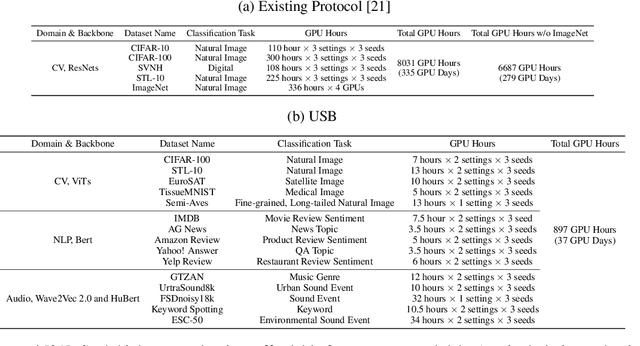

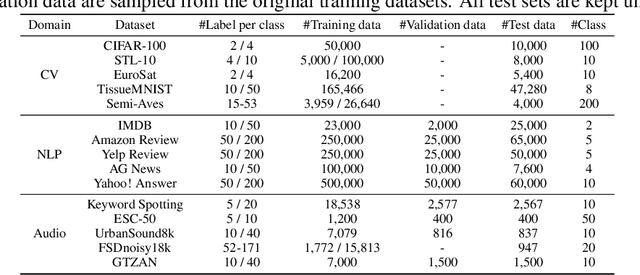

Abstract:Semi-supervised learning (SSL) improves model generalization by leveraging massive unlabeled data to augment limited labeled samples. However, currently, popular SSL evaluation protocols are often constrained to computer vision (CV) tasks. In addition, previous work typically trains deep neural networks from scratch, which is time-consuming and environmentally unfriendly. To address the above issues, we construct a Unified SSL Benchmark (USB) by selecting 15 diverse, challenging, and comprehensive tasks from CV, natural language processing (NLP), and audio processing (Audio), on which we systematically evaluate dominant SSL methods, and also open-source a modular and extensible codebase for fair evaluation on these SSL methods. We further provide pre-trained versions of the state-of-the-art neural models for CV tasks to make the cost affordable for further tuning. USB enables the evaluation of a single SSL algorithm on more tasks from multiple domains but with less cost. Specifically, on a single NVIDIA V100, only 37 GPU days are required to evaluate FixMatch on 15 tasks in USB while 335 GPU days (279 GPU days on 4 CV datasets except for ImageNet) are needed on 5 CV tasks with the typical protocol.
Improved Consistency Training for Semi-Supervised Sequence-to-Sequence ASR via Speech Chain Reconstruction and Self-Transcribing
May 14, 2022
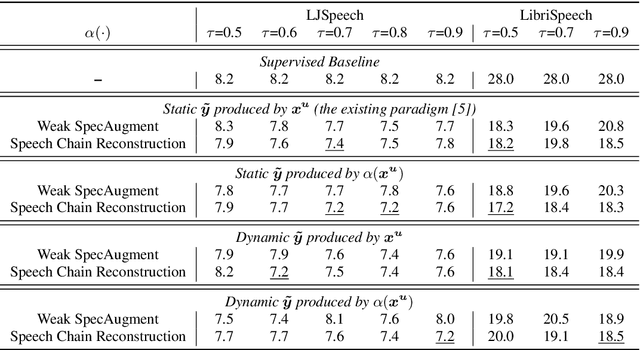
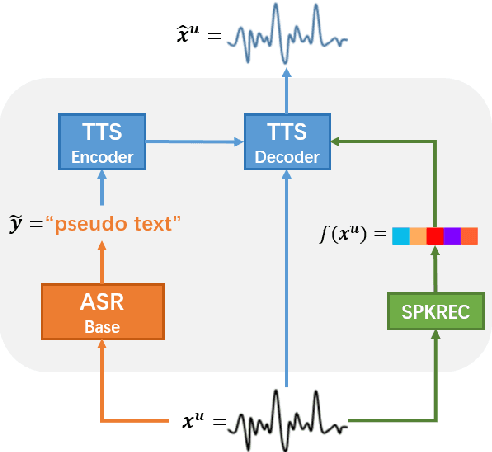
Abstract:Consistency regularization has recently been applied to semi-supervised sequence-to-sequence (S2S) automatic speech recognition (ASR). This principle encourages an ASR model to output similar predictions for the same input speech with different perturbations. The existing paradigm of semi-supervised S2S ASR utilizes SpecAugment as data augmentation and requires a static teacher model to produce pseudo transcripts for untranscribed speech. However, this paradigm fails to take full advantage of consistency regularization. First, the masking operations of SpecAugment may damage the linguistic contents of the speech, thus influencing the quality of pseudo labels. Second, S2S ASR requires both input speech and prefix tokens to make the next prediction. The static prefix tokens made by the offline teacher model cannot match dynamic pseudo labels during consistency training. In this work, we propose an improved consistency training paradigm of semi-supervised S2S ASR. We utilize speech chain reconstruction as the weak augmentation to generate high-quality pseudo labels. Moreover, we demonstrate that dynamic pseudo transcripts produced by the student ASR model benefit the consistency training. Experiments on LJSpeech and LibriSpeech corpora show that compared to supervised baselines, our improved paradigm achieves a 12.2% CER improvement in the single-speaker setting and 38.6% in the multi-speaker setting.
 Add to Chrome
Add to Chrome Add to Firefox
Add to Firefox Add to Edge
Add to Edge